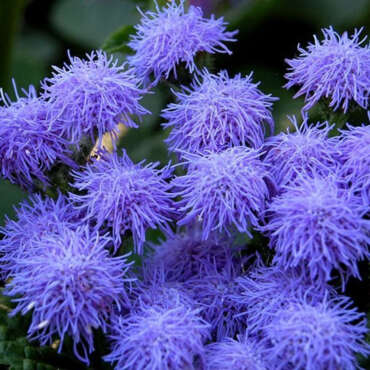Product Description
Ageratum “Blue” – Flats (36)
The color blue, a rarity in the gardening world, is highly coveted by avid gardeners. Ageratum is grown for its whimsical pompom-shaped flowers that occur mostly in shades of blue, though colors also include white, pink, lavender, and red. These popular bedding plants are most often purchased as nursery starts in tray packs or flats, but can also be grown from seed. With sizes ranging from a few inches high to three feet tall, ageratum can be grown in containers, used as edging along pathways or borders, or massed in displays.
Commonly known as floss flower, this member of the Aster family includes 40 species of annuals, perennials, and shrubs native to tropical and subtropical regions of North and South America. Billygoat weed (Ageratum conyzoides), which has herbal and medicinal qualities, is highly invasive, primarily in Africa, but can also be found growing wild in parts of the Southern US. The ornamental varieties available to home gardeners are grown as annuals, and are attractive to butterflies, hummingbirds, and insect pollinators.
THE BASICS
Zones:
Usually grown as an annual; perennial in Zones 10-11.
Height/Spread:
4 to 36 inches tall, 6 to 18 inches wide.
Exposure:
Full sun to partial shade. Ageratum plants will flower best in full sun; too much shade can result in less blooms and leggy plants. In hotter regions, plants benefit from afternoon shade.
Bloom time:
From late spring to frost.
Color and characteristics:
Also known as floss flower for its floss-like petals, the tiny blooms resemble fluffy pompoms. Flowers are produced in dense clusters in colors of blue, purple, red, white, or pink. Leaves are medium green and oval or lance-shaped. Plant habit ranges from short and densely compact to upright and loose.
Toxicity:
Ageratum can be toxic to grazing animals, causing liver lesions. All parts of the plant are poisonous and may be harmful to pets or humans if ingested. Call poison control or your local veterinarian for advice if necessary.
PLANTING INSTRUCTIONS
Try a sun-loving combo like this ‘Across the Universe’ container recipe that includes: Angelface® Perfectly Pink angelonia, Artist® Blue ageratum, and Diamond Delight® euphorbia. Video by: Proven Winners.
When to plant:
Plant nursery starts outdoors from late spring to early summer after all danger of frost is past. Sow seed indoors 8 to 10 weeks before your last average frost date. Seeds can be sown directly outdoors after your average last frost date; however, plants will not bloom until late summer or fall. Ageratums are heat lovers and will fail to thrive if it’s too cold.
Where to plant:
In a bed or container with rich, well-draining soil that will stay evenly moist.
How to plant:
Press seeds gently into the soil mix and don’t cover, as seeds need light to germinate. Keep moist until leaves emerge (5 to 14 days), and transplant outdoors after all danger of frost is past. For nursery starts, remove plant from the container and gently tease out the roots if potbound. Dig a hole and place so the top of the root ball is level with the soil surface. Gently tamp down soil around the base and water well. Space taller varieties 12 inches apart, and shorter varieties 6 inches apart.
AGERATUM CARE
Pruning and maintenance:
While most will require deadheading to encourage new flowers, others like the Artist® series will grow up over the spent blooms, covering them up, and may not need deadheading to look good. Cut back if plants start looking tired or are outgrowing the space; they should rebloom within a week or two.
Soil:
Plant in well-amended soil that drains well. Ageratum is not fussy about soil pH.
Amendments & fertilizer:
Ageratums are heavy feeders and benefit from regular fertilizing. Mix a granular slow-release fertilizer into the soil at the time of planting and reapply mid-season, or use a water-soluble fertilizer twice monthly according to package instructions. Yellow leaves may be a sign that plants aren’t receiving enough fertilizer. Mulch with organic material such as shredded leaves or compost to suppress weeds and conserve moisture. Keep mulch several inches away from the base of the plant to avoid crown or stem rot.
Watering:
Ageratums have shallow roots, so they can quickly dry out and wilt. Provide consistent water at least weekly, or more as needed during warm spells. To prevent foliar diseases, water in the morning so plants can dry out, or irrigate around the base of the plants rather than overhead.
Diseases and pests:
When planted in the ideal site, ageratums are resistant to most pests and diseases. Too much shade, lack of air circulation, or high humidity can cause fungal diseases such as powdery mildew. Poor drainage or overwatering can result in root rot. Possible insect problems include spider mites, aphids, and whiteflies.
Deer resistance:
Deer will generally leave ageratum alone, though extreme conditions can result in deer grazing on plants that they wouldn’t otherwise.
Information from www.gardendesign.com
Specifications
- Weight: 15 lb
- >>: Colors are approximate

